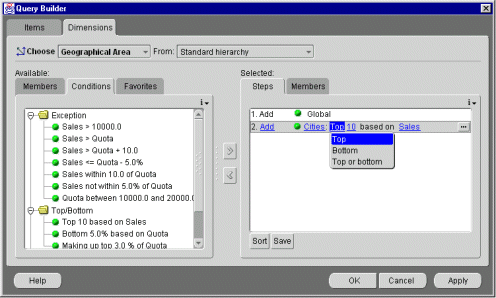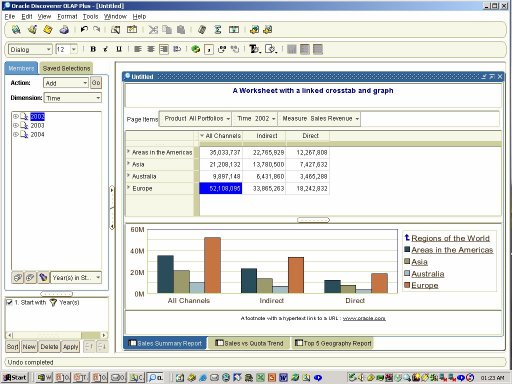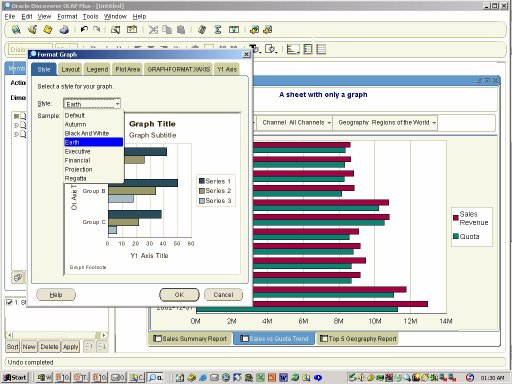Previewing The Next Generation Of Oracle Discoverer
One of the most interesting presentations being given at next weeks' UKOUG Reporting Tools & BIW Special Event is a preview of the next generation of Oracle Discoverer, known by the codename 'Drake'. Oracle haven't officially released details of Discoverer Drake yet, but it's possible now to pull together a picture of what the product is likely to look like, and it's looking like quite an exciting development for Discoverer users.
Discoverer Drake (otherwise known as 'Discoverer For OLAP' or sometimes 'Discoverer 10g') is an evolved version of Discoverer Plus that will be delivered as part of the Oracle Application Server 10g product stack. The key feature in Discoverer Drake that makes the product particularly interesting is integration with the Oracle OLAP Option.
Previous versions of Oracle Discoverer could access data held in Oracle 9i OLAP Analytic Workspaces by using SQL views over the data, created using the OLAP_TABLE function either manually, or automatically through tools such as Oracle Warehouse Builder 9i and Analytic Workspace Manager. OWB and AWM allowed you to create two scripts (one that created the SQL views using the OLAP_TABLE function, and one that created the Discoverer EUL entries) that allowed you to access 9i OLAP analytic workspaces as if they were relational tables. Whilst this was a good first step, this approach suffered from two disadvantages - firstly, it bypassed the OLAP Catalog, and therefore didn't take advantage of any of the metadata in this key 9i OLAP feature, and secondly - well, it didn't seem to work very well; it was difficult to set up and you often came across OLAP_TABLE errors, and it just didn't feel very intuitive.
Discoverer Drake does away with this approach and instead, allows you to create workbooks directly against the OLAP Catalog. This functionality is in addition to the traditional approach of defining workbooks using an End User Layer, meaning that Discoverer users will have a choice now when creating new workbooks - they can create reports against the EUL and directly query relational data, or, if their DBA has set up Oracle OLAP and the OLAP Catalog, they can create reports against either relational or multidimensional data as defined in the OLAP Catalog.
When a user builds a new query, they will be able to either define it against the traditional EUL, or if their data is held in an Oracle OLAP cube, they will now be able to define the query against the OLAP Catalog. Reports built against the OLAP Catalog will use the BI Beans query bean to build up the query, offering a much richer data selection tool than found in previous versions of Oracle Discoverer.

One of the key features of the BI Beans query bean is that queries are built up in several stages using normal English terms, allowing you choose a dimension and progressively limit down those members that will form part of the query. This type of query building interface (known to Oracle Express users as the 'Selector') is much more intuitive and flexible than the pure-SQL generating worksheet editor in older versions of Discoverer, allowing you to select dimension members based on values in the fact table ('limit products down to those products who's sales were in the top ten last year') all the while showing you the resulting list of members as defined by your query.
If you don't want to define queries against the OLAP Catalog, the old way of defining queries is still present, and Discoverer will still query relational data in the same way that it does now. What this additional feature gives you is a way of natively querying both relational and multidimensional OLAP data, defined in the OLAP Catalog, if your organization has licensed either the Oracle 9i or Oracle 10g OLAP Option.
For queries defined against the OLAP Catalog, the main Discoverer worksheet interface has been given a facelift, and has with a new Multiple Document Interface (MDI) that embeds the Selector in the left-hand side of the page.
This Selector, again based on the BI Beans Query Bean, allows you to interactively make changes to the dimensions and measures in the worksheet, and allows you to save particular combinations of dimensions and measures using a feature called 'Saved Selections'. The crosstabs, graphs and tables displayed in the main area of the workbook are also built using BI Beans, making this the first packaged product from Oracle that uses this technology.
Workbooks created against the OLAP Catalog also benefit from improved graphing capabilities, allowing you to select styles and make more fine-tuned adjustments to the layout of graphs.
It all looks pretty exciting for Discoverer Plus users. It's not clear yet whether Discoverer Drake will come in a thin-client version, and if so, whether it will be read only (like the current Discoverer Viewer, allowing you to view existing workbooks only) or whether it will allow you to change the workbook layout by utilising the forthcoming thin-client version of the BI Beans Query Bean, as delivered in the upcoming BI Beans 10g Release 2. Likewise, it'll be interesting to hear whether Discoverer Administrator will have any new features for administering the OLAP Catalog (adding users, adding/deleting folders) or whether this will still need to be done using OEM and the AWM.
More details on Discoverer Drake should appear over the next few months. It's still not been announced yet whether we'll have to wait for the next version of Oracle Application Server 10g for it to be delivered, or whether it'll be a separate download that gets installed alongside existing Discoverer Plus and Viewer installations. I'm hoping to hear more details at Andy Osborn's presentation next week, and if there's anything else to add, I'll report back then.

